Hydrological Appraisal of Climate Change Impacts on the Water Resources of the Xijiang Basin, South China
Abstract
:1. Introduction
2. Data and Methodology
2.1. Methodology
2.2. Study Area and Hydrological Data
2.3. Climate Change Scenarios and Datasets
3. Hydrological Modelling and Parametrisation
3.1. Lumped Xinanjiang Model (XAJ)
3.2. Distributed Liuxihe Model (LXH)
3.3. Model Calibration and Validation
4. Results and Discussion
4.1. Evaluation of Rainfall Products from the Climate Model
4.2. Future Rainfall–Runoff Simulations
5. Summary and Concluding Comments
- (1)
- Both the distributed LXH model and lumped XAJ models can reproduce almost equally well the historical runoff data series. The simulated peak flows were more accurate in the LXH model, while the base flow was better simulated by the XAJ model.
- (2)
- The cumulative catchment daily rainfall produced from the climate model matched the rain gauge measurements very well, but they tended to produce more small and medium peak flows and to underestimate the high peak flows during the hydrological model simulations.
- (3)
- Using RCP4.5 and RCP8.5 precipitation data as input to the tested models, marginal variations were found in the median flow simulation in the same hydrological model, which may imply that the difference of the impact from the two climate scenarios on the monthly streamflow simulation in this study was small.
- (4)
- Under future climate conditions, the distributed LXH model produced more streamflow than the lumped XAJ model during January to August, but more streamflow was modelled in the XAJ model than in the LXH model from September to December.
- (5)
- The RCP4.5 climate data could result in the smallest and the highest annual streamflow in the XAJ and LXH models respectively before 2050, but the RCP8.5 rainfall data could produce the smallest annual streamflow in the XAJ and the highest annual streamflow in the LXH model from 2050 to 2099.
- (6)
- The flood frequency analysis suggests that the floods under climate change in the future will be more severe than the historical floods, especially under the RCP8.5 scenario in the LXH model simulations.
Acknowledgments
Author Contributions
Conflicts of Interest
References
- Houghton, J.T.; Jenkins, G.J.; Ephraums, J.J. (Eds.) Climate Change. The IPCC Assessment; Cambridge University Press: New York, NY, USA, 1990. [Google Scholar]
- Jiang, T.; Chen, Y.D.; Xu, C.Y.; Chen, X.; Chen, X.; Singh, V.P. Comparison of hydrological impacts of climate change simulated by six hydrological models in the Dongjiang Basin, South China. J. Hydrol. 2007, 336, 316–333. [Google Scholar] [CrossRef]
- Xu, C.Y.; Widén, E.; Halldin, S. Modelling hydrological consequences of climate change-progress and challenges. Adv. Atmos. Sci. 2005, 22, 789–797. [Google Scholar] [CrossRef]
- Wigley, T.M.L.; Jones, P.D.; Briffa, K.R.; Smith, G. Obtaining sub-gridscale information from coarse-resolution general circulation model output. J. Geophys. Res. 1990, 95, 1943–1953. [Google Scholar] [CrossRef]
- Carter, T.R.; Parry, M.L.; Harasawa, H.; Nishioka, S. IPCC Technical Guidelines for Assessing Climate Change Impacts and Adaptions; IPCC Special Report to Working Group II of IPCC; Department of Geography, University College London: London, UK, 1994. [Google Scholar]
- Fowler, H.J.; Blenkinsop, S.; Tebaldi, C. Review Linking climate change modelling to impacts studies: Recent advances in downscaling techniques for hydrological modelling. Int. J. Climatol. 2007, 27, 1547–1578. [Google Scholar] [CrossRef]
- Wang, D.; Hagen, S.C.; Alizad, K. Climate change impact and uncertainty analysis of extreme rainfall events in the Apalachicola River basin, Florida. J. Hydrol. 2013, 480, 125–135. [Google Scholar] [CrossRef]
- Wood, A.W.; Leung, L.R.; Sridhar, V.; Lettenmaier, D.P. Hydrologic implications of dynamical and statistical approaches to downscaling climate model outputs. Clim. Chang. 2004, 62, 189–216. [Google Scholar] [CrossRef]
- Immerzeel, W.W.; Droogers, P.; de Jong, S.M.; Bierkens, M.F.P. Large-scale monitoring of snow cover and runoff simulation in Himalayan river basins using remote sensing. Remote Sens. Environ. 2009, 113, 40–49. [Google Scholar] [CrossRef]
- Raposo, J.R.; Dafonte, J.; Molinero, J. Assessing the impact of future climate change on groundwater recharge in Galicia-Costa, Spain. J. Hydrol. 2013, 21, 459–479. [Google Scholar] [CrossRef]
- Clark, M.P.; Slater, A.G.; Rupp, D.E.; Woods, R.A.; Vrugt, J.A.; Gupta, H.V.; Wagener, T.; Hay, L.E. Framework for Understanding Structural Errors (FUSE): A modular framework to diagnose differences between hydrological models. Water Resour. Res. 2008, 44, W00B02. [Google Scholar] [CrossRef]
- Boorman, D.B.; Sefton, C.E.M. Recognising the uncertainty in the quantification of the effects of climate change on hydrological response. Clim. Chang. 1997, 35, 415–434. [Google Scholar] [CrossRef]
- Panagoulia, D.; Dimou, G. Linking space-time scale in hydrological modelling with respect to global climate change. Part 1. Models, model properties, and experimental design. J. Hydrol. 1997, 194, 15–37. [Google Scholar] [CrossRef]
- Panagoulia, D.; Dimou, G. Linking space-time scale in hydrological modelling with respect to global climate change. Part 2. Hydrological response for alternative climates. J. Hydrol. 1997, 194, 38–63. [Google Scholar] [CrossRef]
- Li, F.; Xu, Z.; Liu, W.; Zhang, Y. The impact of climate change on runoff in the Yarlung Tsangpo River basin in the Tibetan Plateau. Stoch. Environ. Res. Risk Assess. 2014, 28, 517–526. [Google Scholar] [CrossRef]
- Fischer, T.; Gemmer, M.; Su, B.; Scholten, T. Hydrological long-term dry and wet periods in the Xijiang river basin, south china. Hydrol. Earth Syst. Sci. 2013, 17, 135–148. [Google Scholar] [CrossRef] [Green Version]
- Gotzinger, J.; Bardossy, A. Generic error model for calibration and uncertainty estimation of hydrological models. Water Resour. Res. 2008, 44, 35. [Google Scholar] [CrossRef]
- Browning, D.M.; Duniway, M.C. Digital soil mapping in the absence of field training data: A case study using terrain attributes and semiautomated soil signature derivation to distinguish ecological potential. Appl. Environ. Soil Sci. 2011, 2011, 421904. [Google Scholar] [CrossRef]
- Duan, Q.; Sorooshian, S.; Gupta, V.K. Effective and efficient global optimization for conceptual rainfall–runoff models. Water Resour. Res. 1992, 28, 1015–1031. [Google Scholar] [CrossRef]
- Zhang, S.; Lu, X.X.; Higgitt, D.L.; Chen, C.T.A.; Han, J.; Sun, H. Recent changes of water discharge and sediment load in the Zhujiang (Pearl River) Basin, China. Glob. Planet Chang. 2008, 60, 365–380. [Google Scholar] [CrossRef]
- Gao, X.J.; Wang, M.L.; Giorgi, F. Climate change over China in the 21st century as simulated by BCC_CSM1. 1-RegCM4.0. Atmos. Ocean. Sci. Lett. 2013, 6, 381–386. [Google Scholar]
- Van Vuuren, D.P.; Edmonds, J.; Kainuma, M.; Riahi, K.; Thomson, A.; Hibbard, K.; Hurtt, G.C.; Kram, T.; Krey, V.; Lamarque, J.F.; et al. The representative concentration pathways: An overview. Clim. Chang. 2011, 109, 5. [Google Scholar] [CrossRef]
- Zhao, R.J. The Xinanjiang model applied in China. J. Hydrol. 1992, 135, 371–381. [Google Scholar]
- Chen, Y.; Ren, Q.; Huang, F.; Xu, H.; Cluckie, I. Liuxihe Model and its modeling to river basin flood. J. Hydrol. Eng. 2010, 16, 33–50. [Google Scholar] [CrossRef]
- Fang, B.; Guo, S.; Wang, S.; Liu, P.; Xiao, Y. Non-identical models for seasonal flood frequency analysis. Hydrol. Sci. J. 2007, 52, 974–991. [Google Scholar] [CrossRef]
- Hosking, J.R.M.; Wallis, J.R. Regional Frequency Analysis: An Approach Based on L-Moments; Cambridge University Press: New York, NY, USA, 1997. [Google Scholar]
- Hosking, J.R. Algorithm as 215: Maximum-likelihood estimation of the parameters of the generalized extreme-value distribution. J. R. Stat. Soc. Ser. C Appl. Stat. 1985, 34, 301–310. [Google Scholar] [CrossRef]
- Das, S. An assessment of using subsampling method in selection of a flood frequency distribution. Stoch. Environ. Res. Risk Assess. 2016, 1–13. [Google Scholar] [CrossRef]
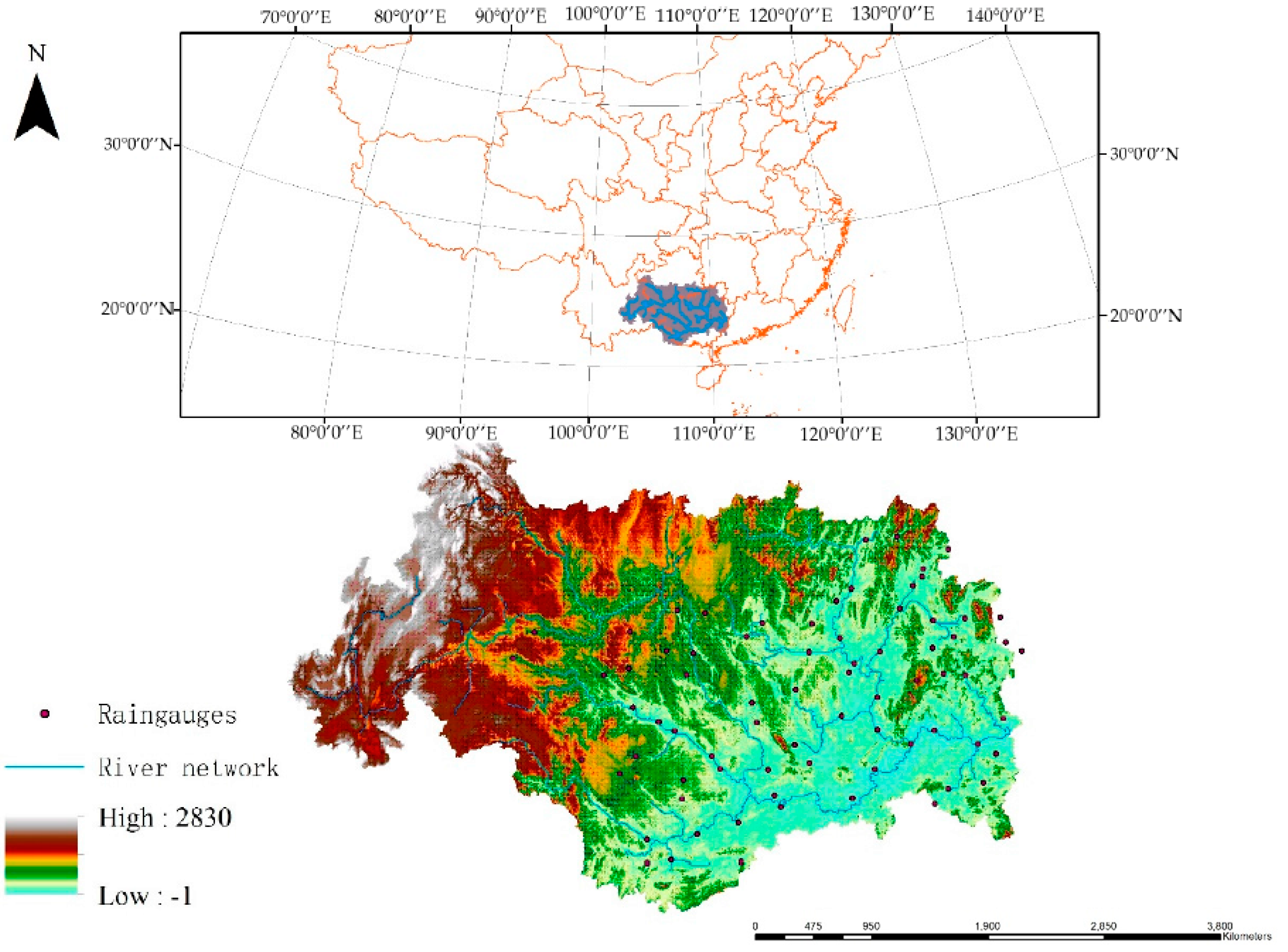
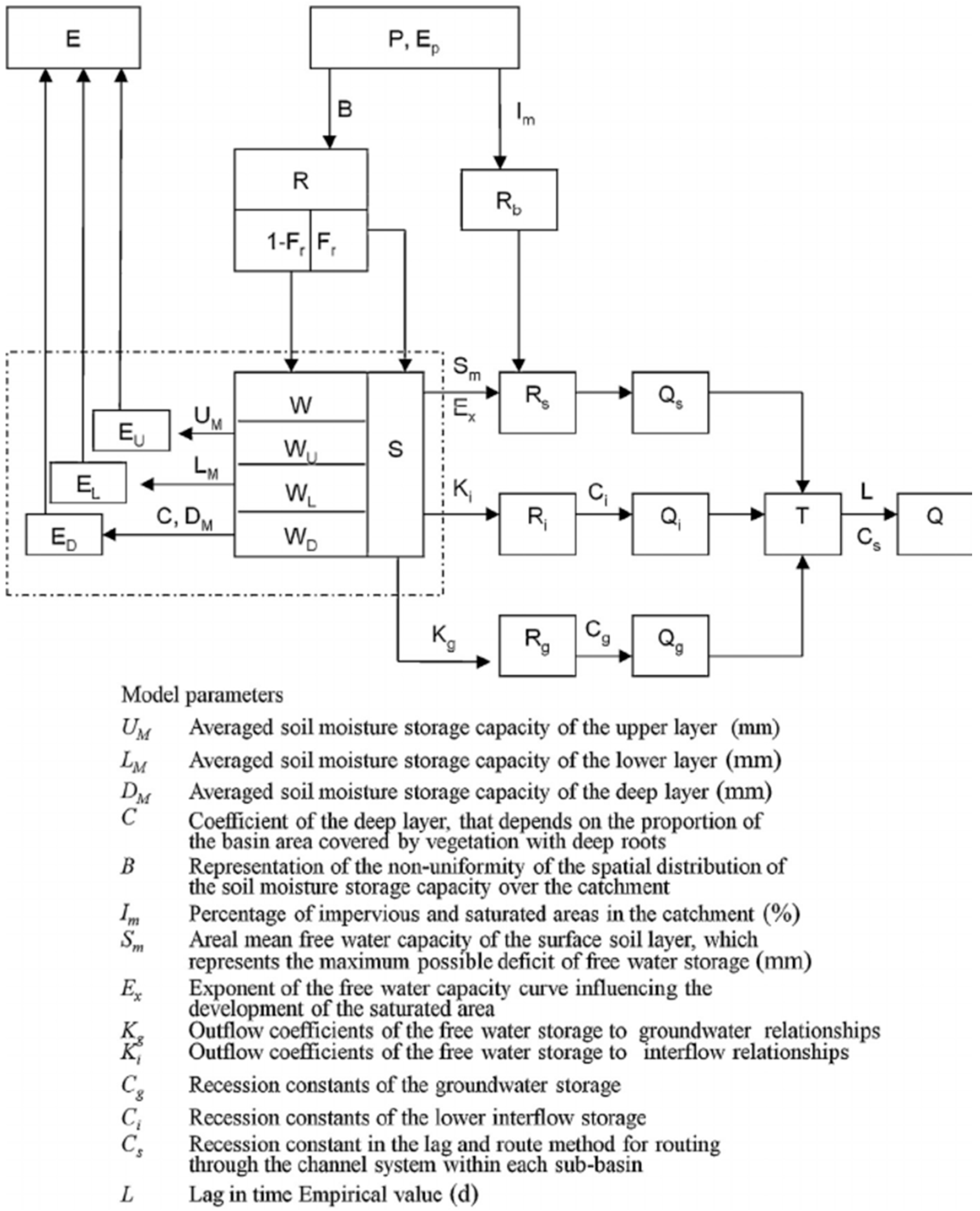
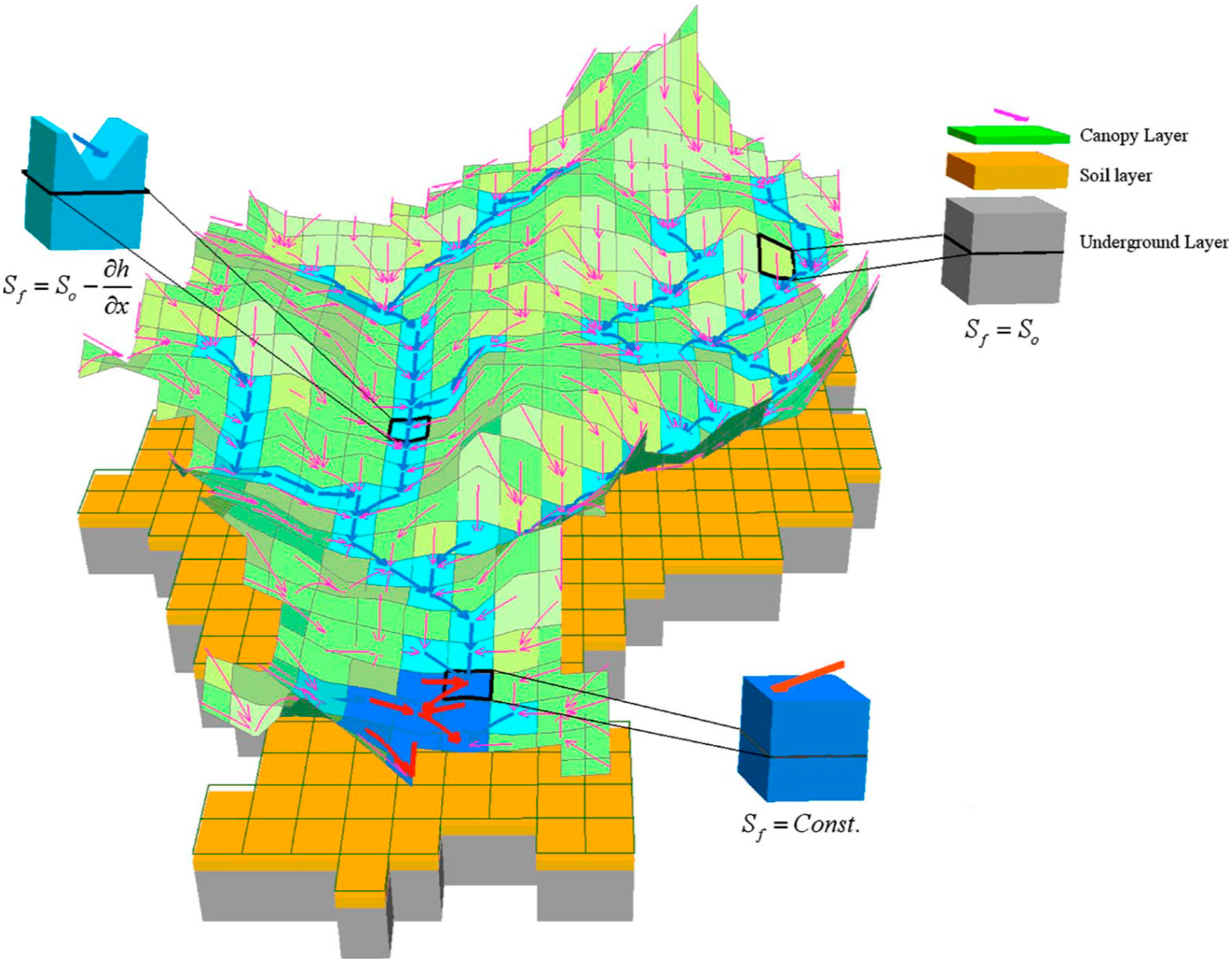

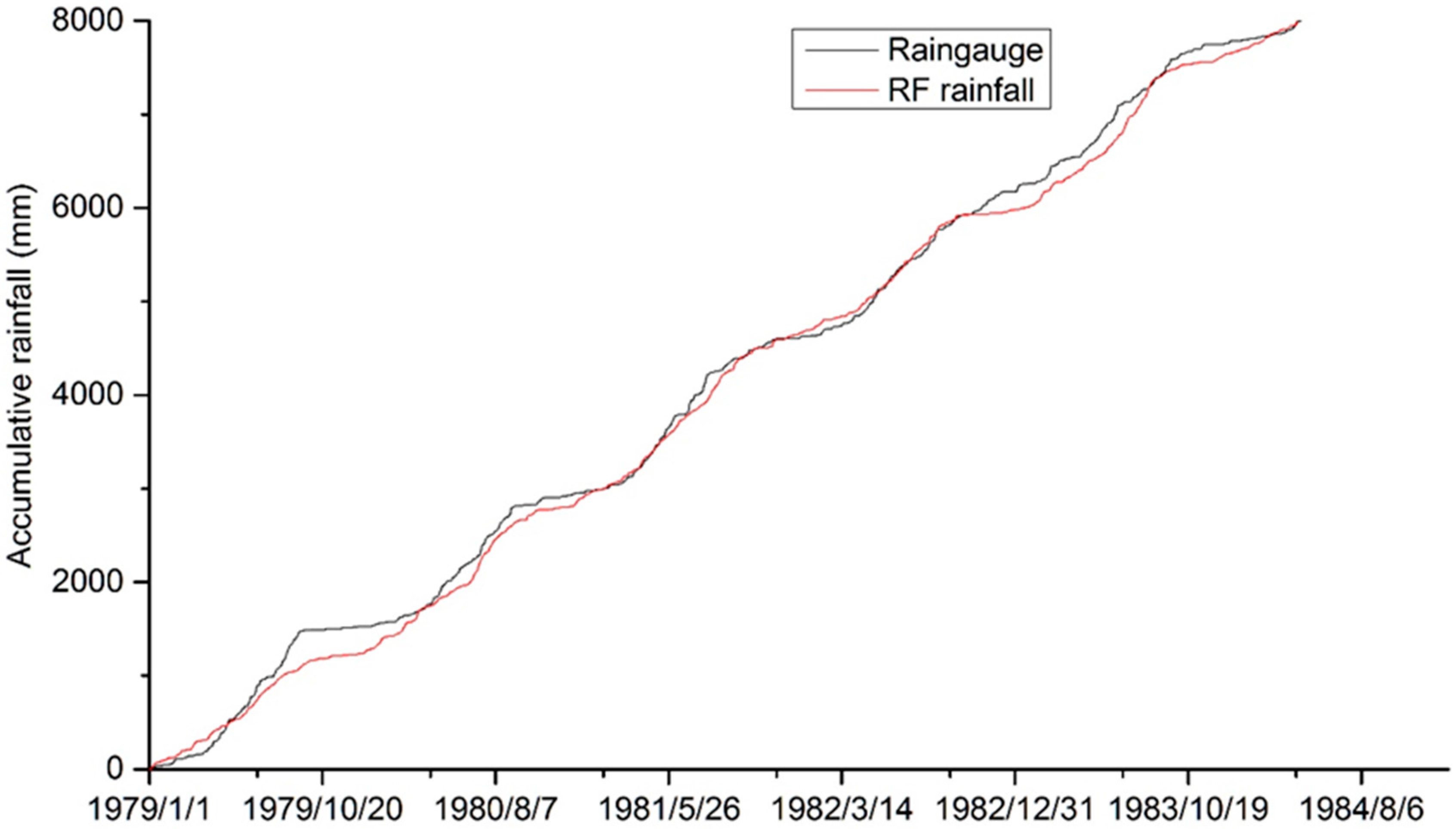
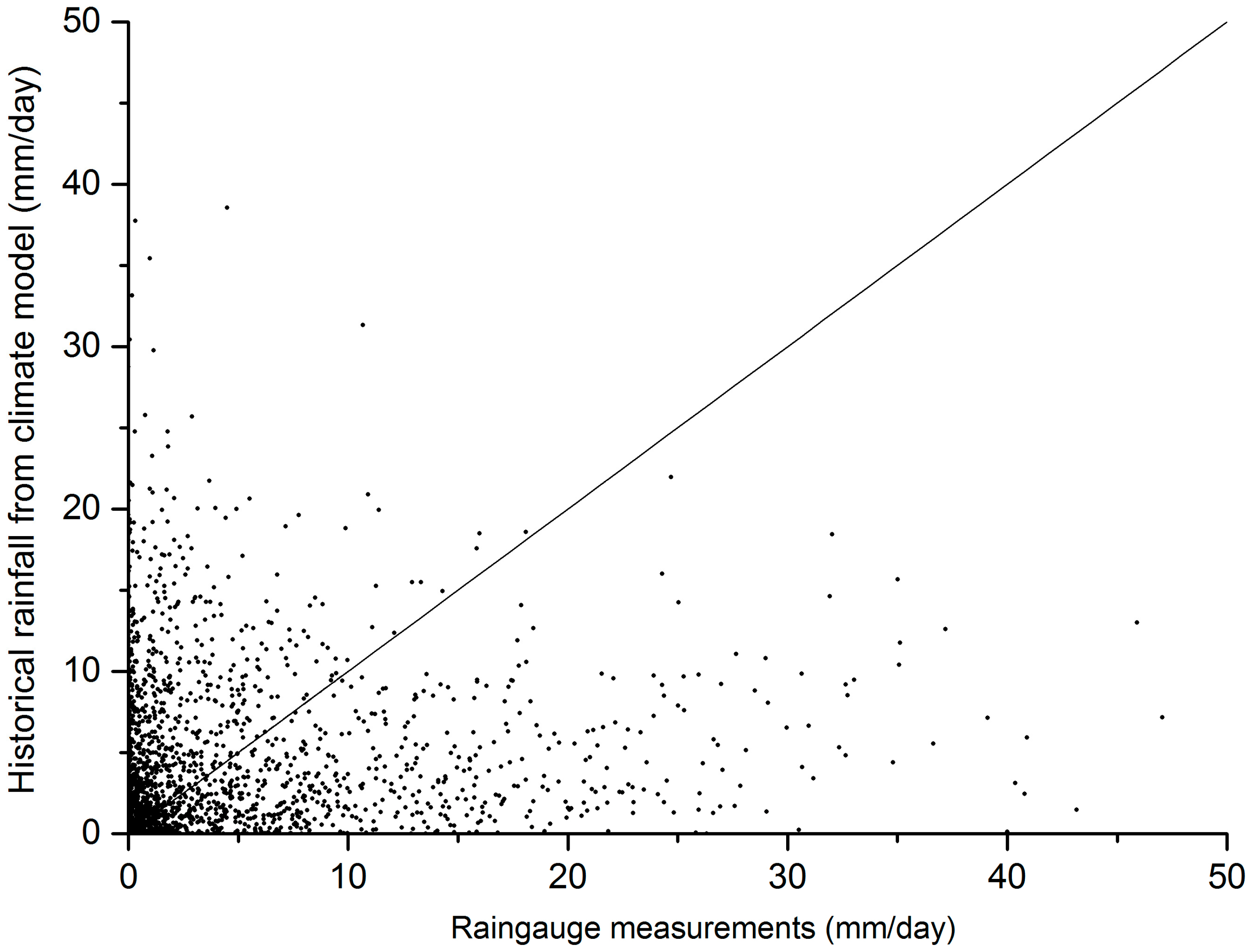
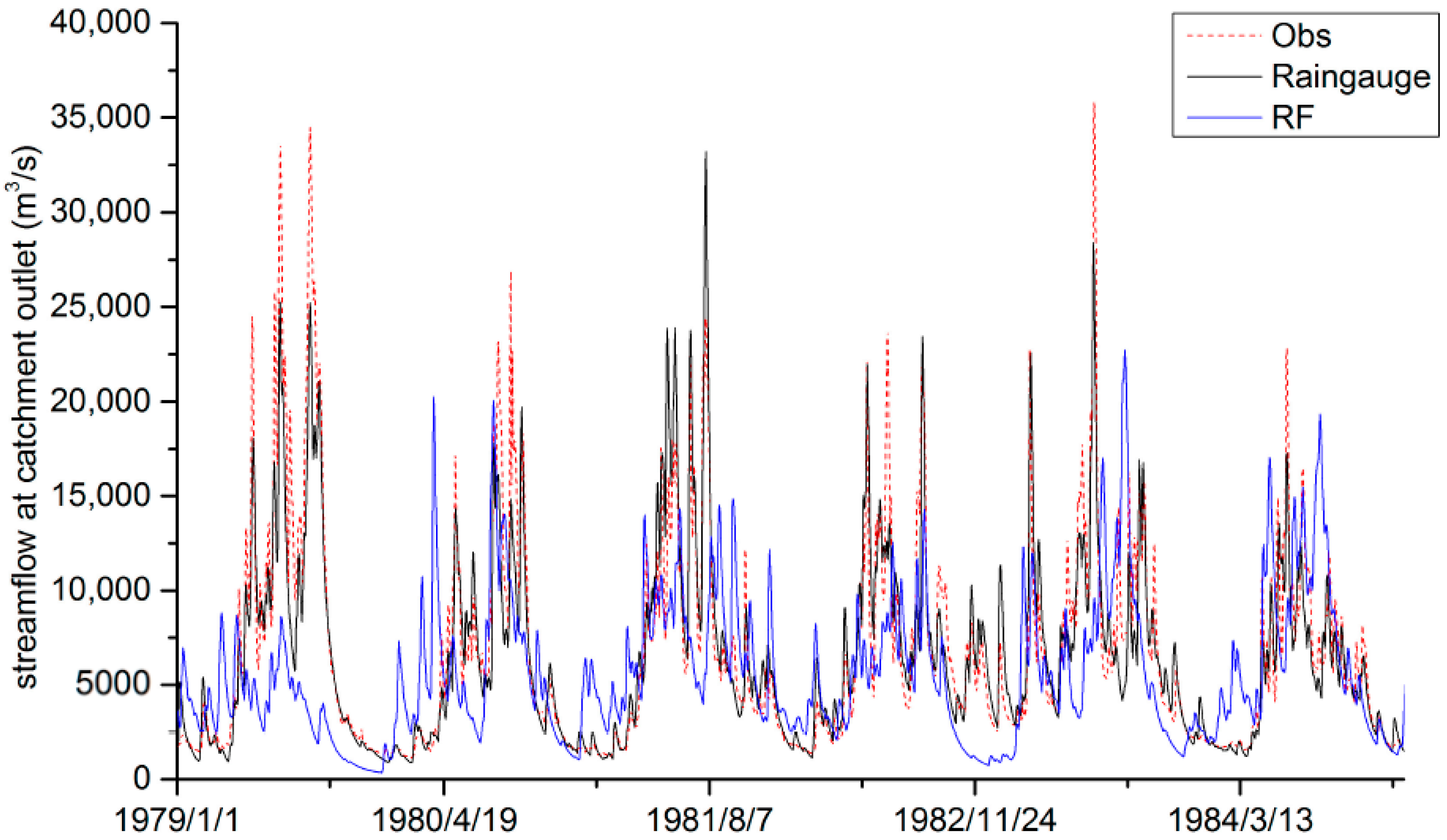
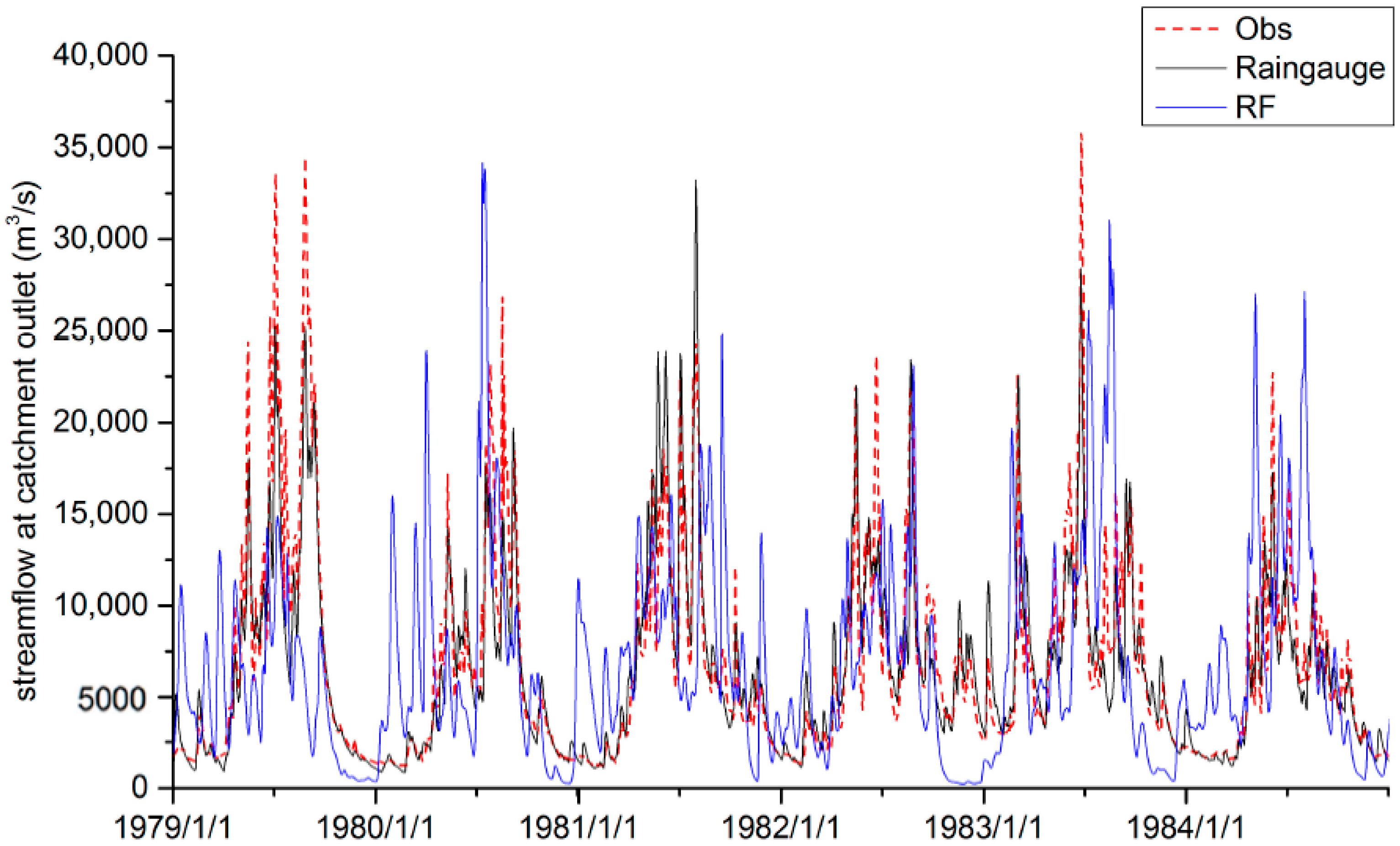
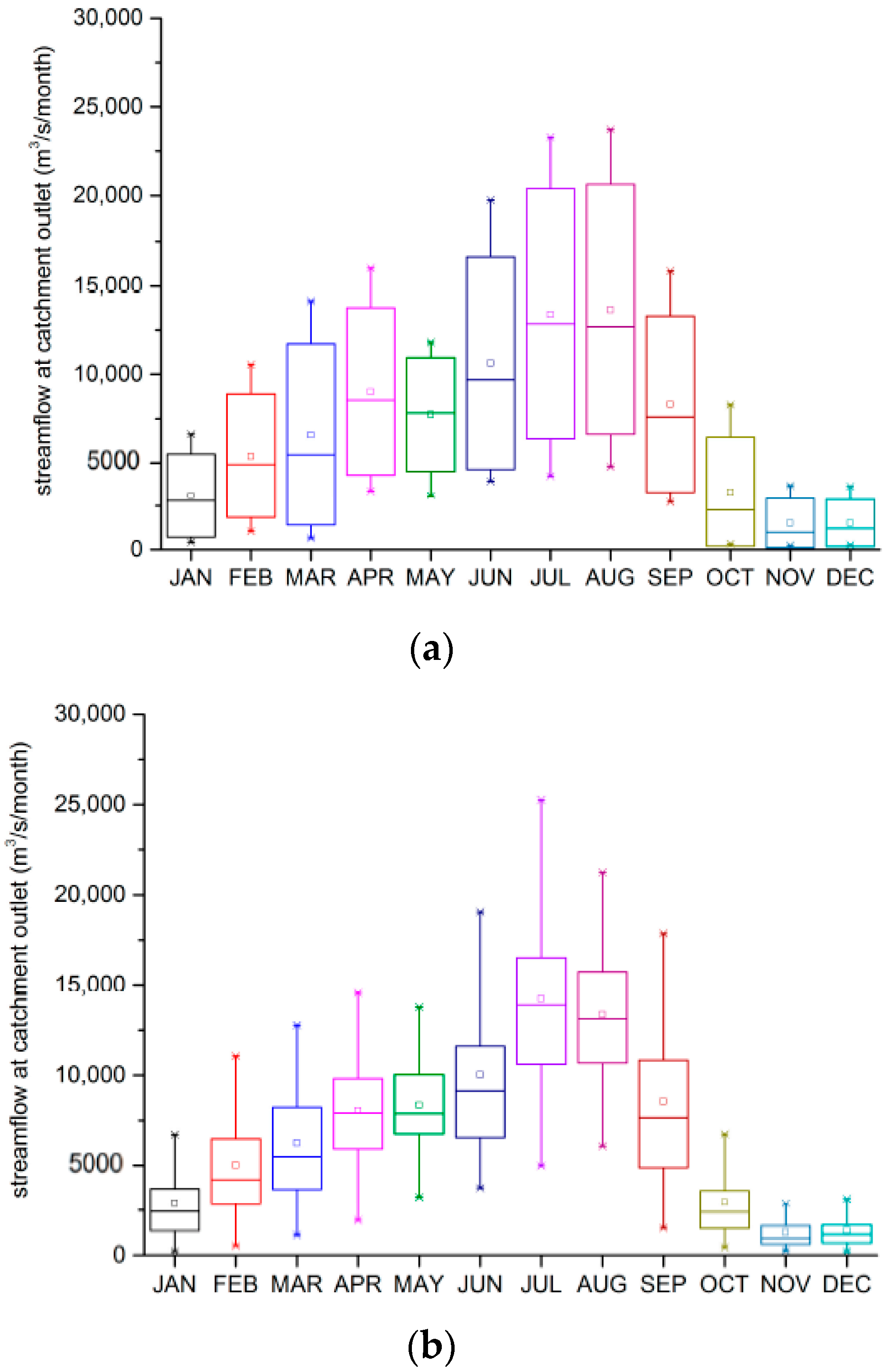
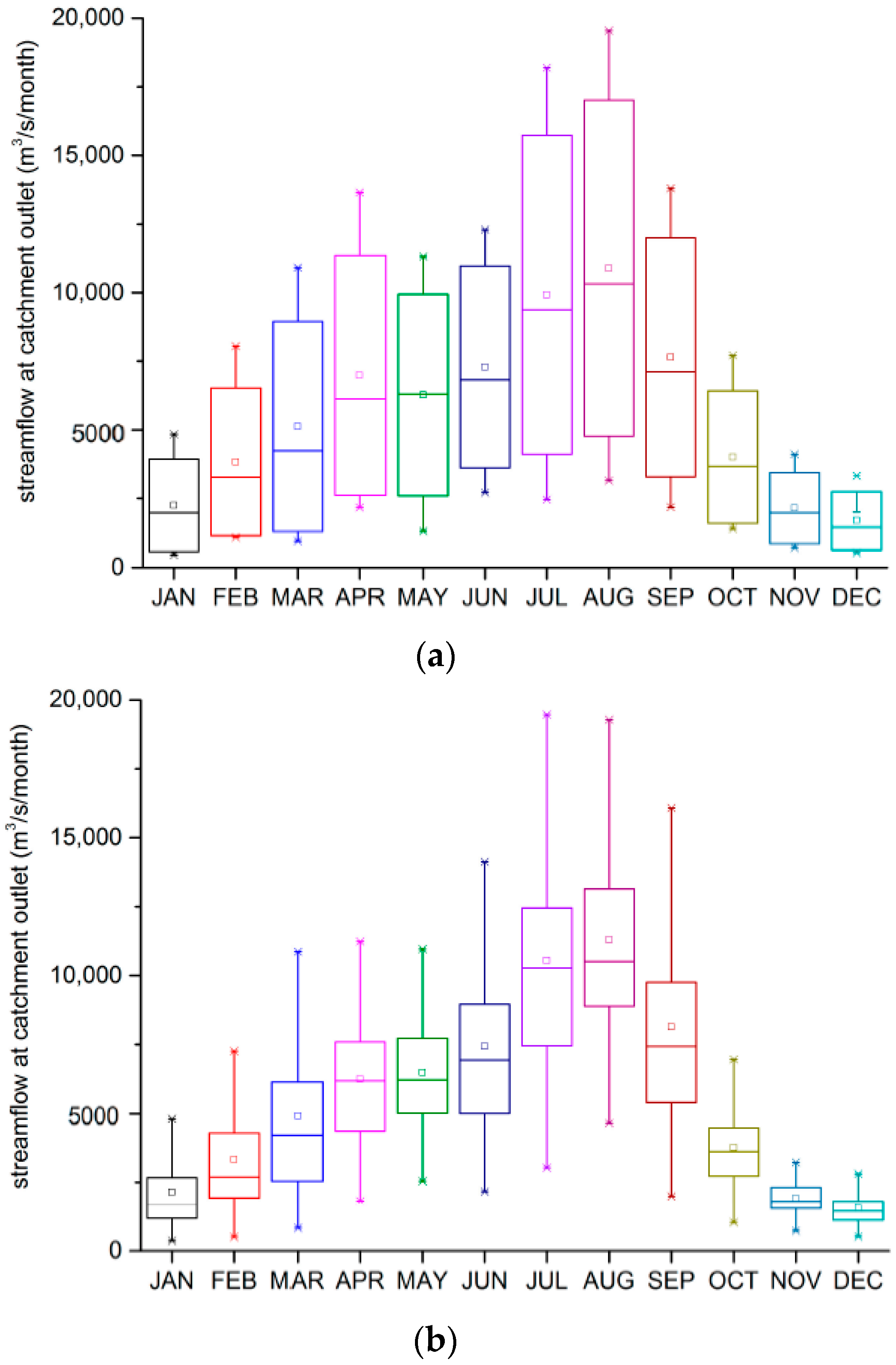
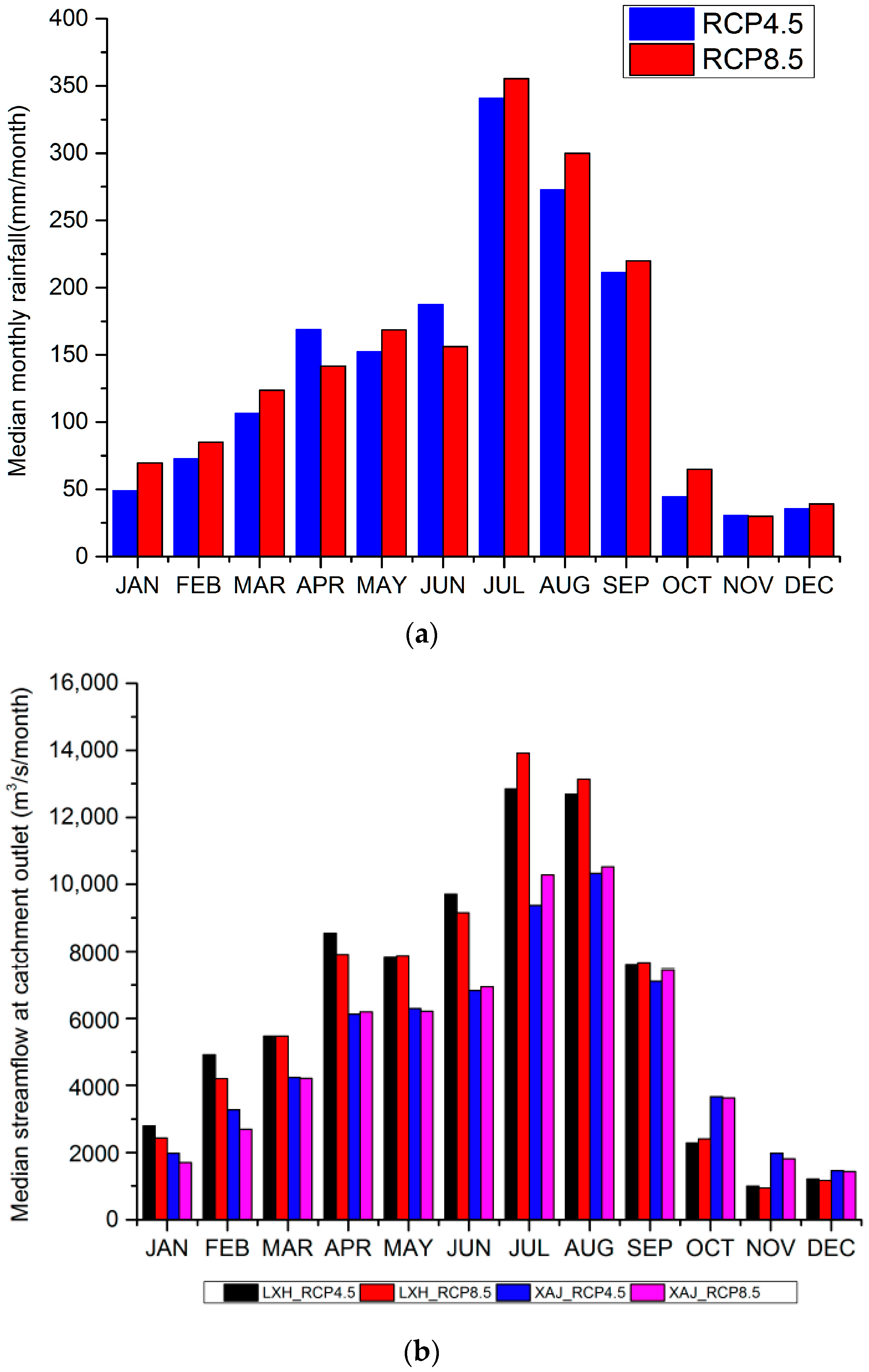
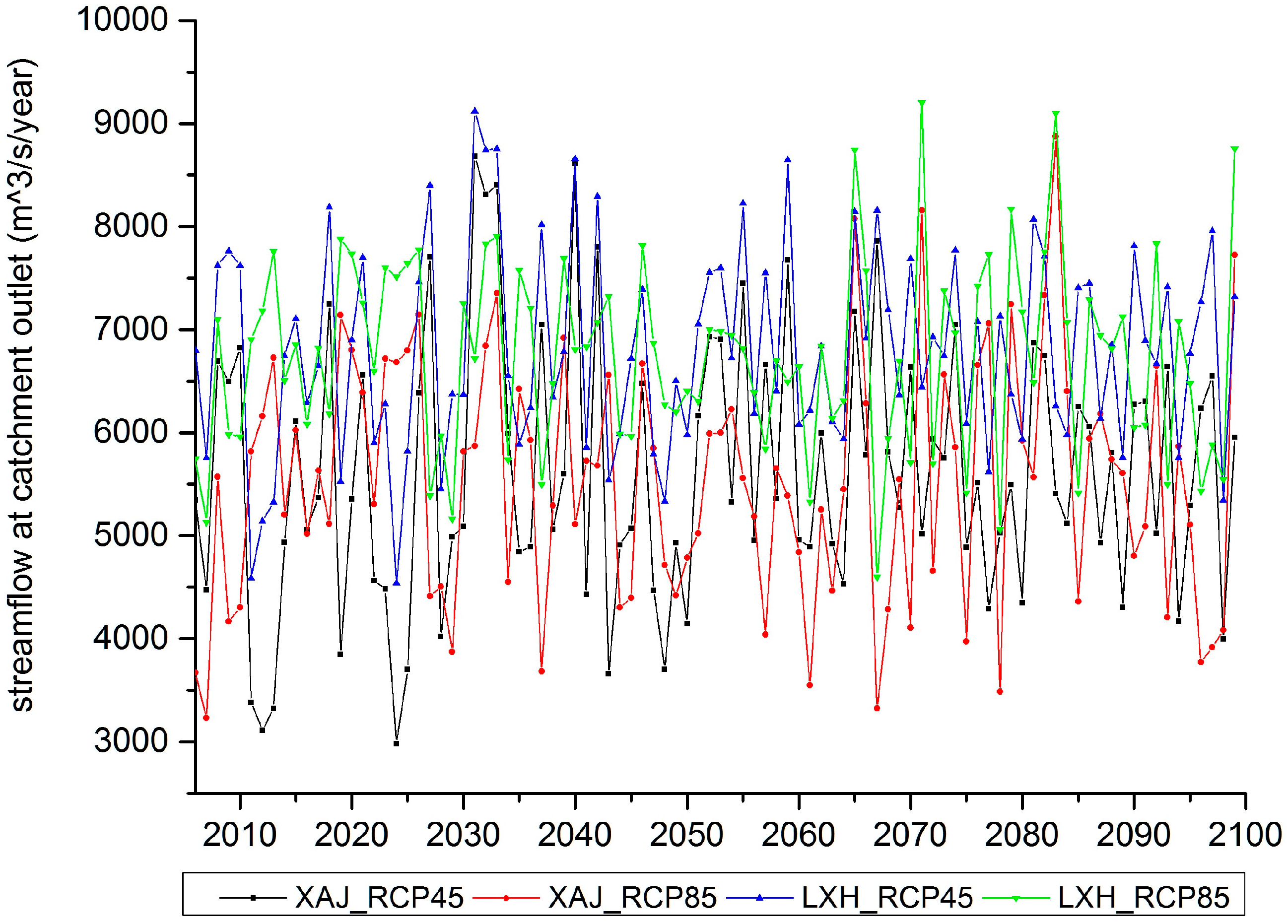
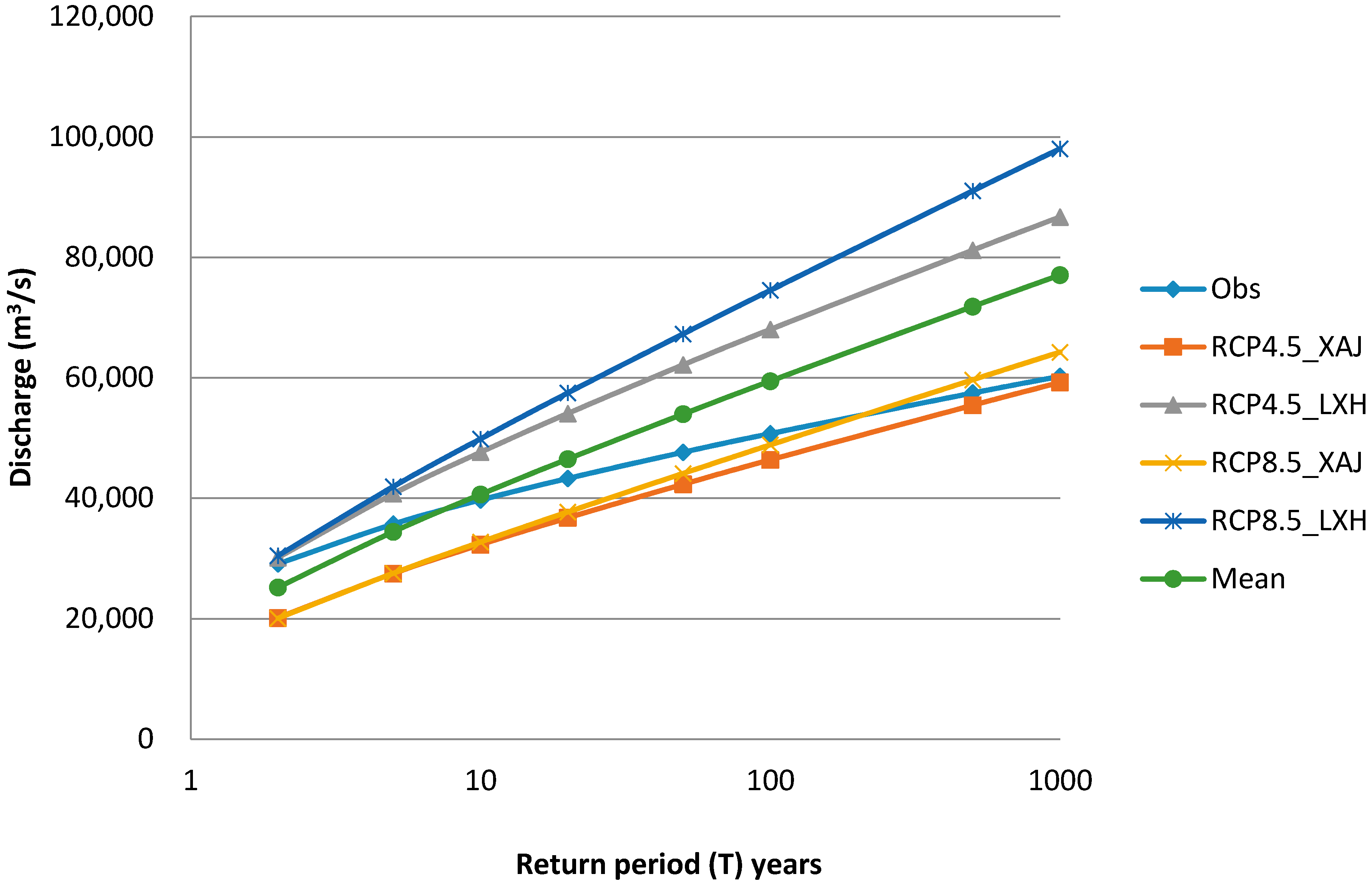
| Criterions | NS | Cor | RMSE | PF | MSLE | |||||
|---|---|---|---|---|---|---|---|---|---|---|
| LXH | XAJ | LXH | XAJ | LXH | XAJ | LXH | XAJ | LXH | XAJ | |
| Calibration | 0.80 | 0.89 | 0.92 | 0.95 | 2898 | 2072 | –1.9% | –3.1% | 0.52 | 0.11 |
| Validation 1 | 0.81 | 0.83 | 0.92 | 0.91 | 2513 | 2365 | –5.3% | –8.6% | 0.56 | 0.08 |
| Validation 2 | 0.60 | 0.72 | 0.92 | 0.93 | 3298 | 2721 | 15% | 18.1% | 0.66 | 0.17 |
| Jan. | Feb. | Mar. | Apr. | May | Jun. | Jul. | Aug. | Sep. | Oct. | Nov. | Dec. | |
|---|---|---|---|---|---|---|---|---|---|---|---|---|
| RCP4.5 | ||||||||||||
| Min | 429 | 1042 | 645 | 3410 | 3144 | 3955 | 4249 | 4764 | 2711 | 339 | 243 | 268 |
| Q1 | 1610 | 3750 | 3782 | 6536 | 6604 | 7232 | 10,512 | 10,712 | 5483 | 1415 | 583 | 609 |
| Median | 2792 | 4917 | 5470 | 8545 | 7826 | 9702 | 12,850 | 12,692 | 7599 | 2282 | 991 | 1199 |
| Q3 | 4065 | 6557 | 8807 | 10,619 | 9280 | 12,536 | 15,967 | 16,267 | 9896 | 4317 | 2032 | 1857 |
| Max | 6630 | 10,550 | 14,131 | 16,013 | 11,810 | 19,743 | 23,287 | 23,715 | 15,834 | 8285 | 3721 | 3662 |
| RCP8.5 | ||||||||||||
| Min | 208 | 518 | 1118 | 1934 | 3225 | 3741 | 4982 | 6077 | 1518 | 430 | 255 | 211 |
| Q1 | 1357 | 2831 | 3668 | 5910 | 6740 | 6544 | 10,607 | 10,680 | 4882 | 1487 | 603 | 688 |
| Median | 2437 | 4193 | 5475 | 7903 | 7870 | 9147 | 13,916 | 13,132 | 7658 | 2405 | 931 | 1156 |
| Q3 | 3705 | 6467 | 8215 | 9824 | 10,050 | 11,623 | 16,507 | 15,731 | 10,835 | 3593 | 1638 | 1681 |
| Max | 6714 | 11,071 | 12,783 | 14,577 | 13,793 | 19,055 | 25,257 | 21,240 | 17,868 | 6734 | 2884 | 3130 |
| Jan. | Feb. | Mar. | Apr. | May | Jun. | Jul. | Aug. | Sep. | Oct. | Nov. | Dec. | |
|---|---|---|---|---|---|---|---|---|---|---|---|---|
| RCP4.5 | ||||||||||||
| Min | 452 | 1085 | 956 | 2168 | 1312 | 2709 | 2458 | 3146 | 2179 | 1384 | 707 | 534 |
| Q1 | 1237 | 2172 | 2927 | 4550 | 4776 | 5342 | 7451 | 7990 | 5557 | 2561 | 1408 | 1126 |
| Median | 1977 | 3274 | 4230 | 6127 | 6297 | 6827 | 9375 | 10,323 | 7109 | 3663 | 1976 | 1451 |
| Q3 | 2748 | 4588 | 6596 | 8445 | 7630 | 9266 | 12,114 | 13,425 | 9556 | 4698 | 2536 | 2005 |
| Max | 4838 | 8050 | 10,908 | 13,647 | 11,315 | 12,305 | 18,193 | 19,545 | 13,801 | 7712 | 4103 | 3324 |
| RCP8.5 | ||||||||||||
| Min | 356 | 496 | 819 | 1817 | 2540 | 2161 | 3036 | 4650 | 1989 | 1024 | 723 | 517 |
| Q1 | 1175 | 1938 | 2546 | 4357 | 5014 | 5005 | 7455 | 8893 | 5398 | 2732 | 1525 | 1106 |
| Median | 1706 | 2690 | 4209 | 6190 | 6216 | 6940 | 10,281 | 10,514 | 7437 | 3620 | 1810 | 1422 |
| Q3 | 2672 | 4286 | 6138 | 7593 | 7722 | 8957 | 12,449 | 13,145 | 9762 | 4476 | 2312 | 1804 |
| Max | 4816 | 7264 | 10,868 | 11,241 | 10,965 | 14,122 | 19,467 | 19,285 | 16,082 | 6960 | 3231 | 2809 |
© 2017 by the authors. Licensee MDPI, Basel, Switzerland. This article is an open access article distributed under the terms and conditions of the Creative Commons Attribution (CC BY) license (http://creativecommons.org/licenses/by/4.0/).
Share and Cite
Zhu, D.; Das, S.; Ren, Q. Hydrological Appraisal of Climate Change Impacts on the Water Resources of the Xijiang Basin, South China. Water 2017, 9, 793. https://doi.org/10.3390/w9100793
Zhu D, Das S, Ren Q. Hydrological Appraisal of Climate Change Impacts on the Water Resources of the Xijiang Basin, South China. Water. 2017; 9(10):793. https://doi.org/10.3390/w9100793
Chicago/Turabian StyleZhu, Dehua, Samiran Das, and Qiwei Ren. 2017. "Hydrological Appraisal of Climate Change Impacts on the Water Resources of the Xijiang Basin, South China" Water 9, no. 10: 793. https://doi.org/10.3390/w9100793





